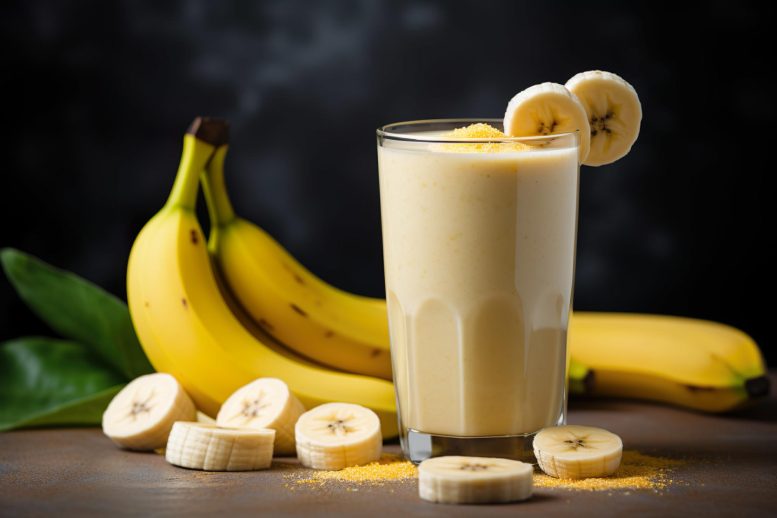
Posted on 05/06/2025 6:17:51 AM PDT by Red Badger

Adding banana to a smoothie dramatically cuts your absorption of heart-healthy flavanols, researchers found, by as much as 84%, thanks to an enzyme bananas contain. Berry-only blends fare far better. Credit: SciTechDaily.com Research helps maximize the health benefits of fruit smoothies.
**********************************************************************************
If you’re blending a smoothie to boost your health with flavanol-rich berries, you may want to leave out the banana. New research suggests that adding banana could significantly reduce the health benefits you’re hoping to gain.
In a study published in Food and Function, scientists tested how a naturally occurring enzyme, polyphenol oxidase, affects the body’s ability to absorb flavanols. This enzyme, responsible for the browning that occurs when fruits are cut or bruised, is found in many fruits and vegetables but is especially abundant in bananas.
Bananas Slash Flavanol Uptake by 84%
The study, led by researchers at the University of California, Davis in partnership with the University of Reading, found that adding a banana to a berry smoothie reduced the absorption of flavanols by a striking 84%. For comparison, participants who took a flavanol capsule absorbed significantly more of these beneficial compounds.
Flavanols are natural compounds known to support heart and brain health. The Academy of Nutrition and Dietetics recommends a daily intake of 400–600 milligrams. A lack of flavanols, especially in older adults, has been linked to cognitive decline and poor cardiovascular function.
Gunter Kuhnle, Professor of Nutrition and Food Science at the University of Reading and co-investigator of the study said: “If you don’t consume enough flavanols, it can negatively affect cardiovascular health. In older adults, a deficiency of flavanols is also linked to cognitive decline. So, it’s clear we need them, but the question is how best to get flavanols from the food and drinks we consume.”

Food Preparation Affects Flavanol Levels, Credit: UC Davis
How Smoothie Ingredients Alter Nutrient Absorption
Lead scientist Javier Ottaviani, director of the Core Laboratory of Mars Edge, which is part of Mars, Inc., and an adjunct researcher with the Department of Nutrition at the University of California, Davis said: “We sought to understand, on a very practical level, how a common food and food preparation like a banana-based smoothie could affect the availability of flavanols to be absorbed after intake.”
Professor Kuhnle said: “Smoothies are a popular way to pack fruit and vegetables into our morning routines. We know from previous studies that flavanols can be broken down by polyphenol oxidase. The extent of the effect from adding a single banana was still very surprising – it had enough polyphenol oxidase to destroy the vast majority of flavanols found in the berries.
“Bananas may be ruled out of the morning smoothie if you want to boost your flavanol intake, but on their own, they are still great fruits an can play an important role in many healthy diets.”
Which Fruits Are Best for Flavanols?
Flavanols are found in apples, pears, blueberries, blackberries, grapes, and cocoa, which are all common smoothie ingredients. But is blitzing them up in a smoothie an effective way to get what you need?
Participants were given a smoothie with banana and berries, one with just mixed berries, or a flavanol capsule. The researchers then took blood and urine samples to measure the flavanols that actually made it through and into the participants’ body.
The researchers found that both the flavanol levels in the smoothie, and the levels absorbed by the body, were reduced when banana was included.
Professor Kuhnle said: “We still know very little about food-food and food-nutrient interactions, even though they can have a huge impact on the uptake of nutrients and bioactives like flavanols.
“Here, we could show that the uptake of flavanols can vary by more than fivefold depending on the combination of foods.
“Bananas are a great ingredient in smoothies to provide a nicer texture, but they can affect flavanol uptake.
Tips for Maximizing Flavanol Intake in Smoothies
“If you want to boost your flavanol intake with a smoothie, you should combine flavanol-rich fruits like berries with foods that have a low polyphenol oxidase activity like pineapple, oranges, mango, or yogurt.”
Reference:
“Impact of polyphenol oxidase on the bioavailability of flavan-3-ols in fruit smoothies: a controlled, single blinded, cross-over study”
by Javier I. Ottaviani, Jodi L. Ensunsa, Reedmond Y. Fong, Jennifer Kimball, Valentina Medici, Gunter G. C. Kuhnle, Alan Crozier, Hagen Schroetera and Catherine Kwik-Uribe, 24 August 2023, Food & Function.
DOI: 10.1039/D3FO01599H
Bananas add sliminess. Veto.
Yes, we have no banana smoothies.
I pour Kefir over frozen blueberries.

This is half-assed science.
Berries offer numerous benefits beyond flavonoids. They are excellent sources of vitamins like Vitamin C and folate, fiber, and minerals. Some berries, like cranberries, are known for their unique properties, such as reducing the risk of urinary tract infections. Berries also contribute to heart health, potentially reducing the risk of cardiovascular disease. Additionally, berries can positively impact cognitive function and may help regulate blood sugar levels.
Yikes!
Must be true. I have never seen a bird with UTI (urinary tract infection).
Polyphenol oxidase, an enzyme involved in fruit browning, is a tetramer that contains four atoms of copper per molecule. PPO may accept monophenols and/or o-diphenols as substrates.
The enzyme works by catalyzing the o-hydroxylation of monophenol molecules in which the benzene ring contains a single hydroxyl substituent to o-diphenols.
Enzymatic browning is a colour reaction occurring in plants, including cereals, fruit and horticultural crops, due to oxidation during postharvest processing and storage. This has a negative impact on the colour, flavour, nutritional properties and shelf life of food products. Browning is usually caused by polyphenol oxidases (PPOs), following cell damage caused by senescence, wounding and the attack of pests and pathogens.
Several studies indicated that PPOs play a role in plant immunity, and emerging evidence suggested that PPOs might also be involved in other physiological processes. Genomic investigations ultimately led to the isolation of PPO homologs in several crops, which will be possibly characterized at the functional level in the near future.
Browning negatively affects the commercial value of many agricultural productions, including apple, banana, cucumber, grape, mango, pear, peach, apricot, eggplant, lettuce, potato and cereals .
Polyphenol oxidase (PPO) is a copper-containing phenolase discovered in most animals, plants (not found in Arabidopsis thaliana, Brassica napus, and green algae), and microorganisms.
In plants, PPO is encoded by multiple genes from the nuclear genome. Various PPO genes are found in the same plant. Nine PPO genes (StPOTP1, StPOTP2, StPOT32, StPOT33, StPOT72, and StuPPO5–StuPPO9) were isolated in potato. Also, four PPO genes (BPO1, BPO11, BPO34, and BPO35) were cloned in bananas. Tomato contains seven PPO genes, whereas just one PPO gene was found in cucumber. The largest number of PPO genes exists in Salvia miltiorrhiza, which contains 26 members.
Everything is good for you.
Everything is bad for you.
Everything is good for you, until it is bad for you.
Everything is bad for you, until it is good for you................
So they tested a smoothie against a supplement? Shouldn’t they have studied a smoothie with a banana against that same smoothie without a banana?
My smoothies are OJ, a banana and a scoop of Slim Fast powder.
Studies show and experts say....
Bkmk
Disclaimer: Opinions posted on Free Republic are those of the individual posters and do not necessarily represent the opinion of Free Republic or its management. All materials posted herein are protected by copyright law and the exemption for fair use of copyrighted works.